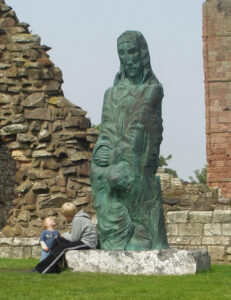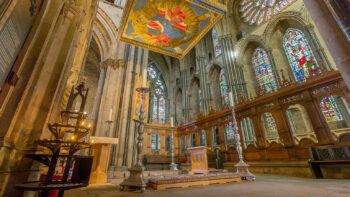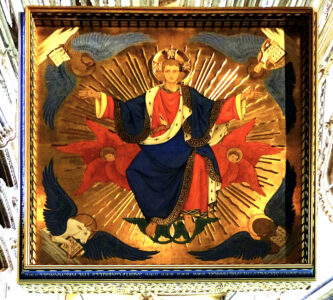St Cuthbert of Holy Island
 By Anthony E Dundon
By Anthony E Dundon
In the ruins of Holy Island, Lindisfarne, off the north-east coast of England, where Irish monks settled in 635, the statue of Saint Cuthbert stands sentinel. Much of what is known about St Cuthbert, bishop of Lindisfarne and patron of Durham, is legendary. He was probably a devout man, who loved solitude and inspired his fellow men. Cuthbert was born in 635. His biographers claim that he may have been the son of an Irish king called Muiredach, and while some members of the clergy supported this theory, many English writers later rejected it. It is more likely that he was born in Melrose, which is in present-day Scotland, where he tended sheep in the mountains close to Melrose Abbey.

OLYMPUS DIGITAL CAMERA
In 651, when he was 16, he saw in a vision the heart of Saint Aidan, the founder of Lindisfarne Abbey, being carried up to heaven by the angels. It was this phenomenon that inspired him to become a monk at Melrose, but he was also influenced by the holiness of Saints Eta, the abbot and Basil, the prior. First, however, he had to endure four years’ military service in the conflict between the Mercians and Northumbrians, which culminated in the defeat of the Mercians at the Battle of Winwaed (a now forgotten river). Here he was engaged in fierce fighting with this pagan enemy that entailed much bloodshed, and many monks were slaughtered.
After Winwaed, Cuthbert entered Melrose Abbey, which was founded in 650. The abbey was raided in 839 and later fell into ruin, and is two miles to the east of St Mary’s Abbey, a Cistercian monastery built by the Benedictines in 1136. He was soon distinguished for his holiness and praised for his devotion to God. When a new monastery was founded at Ripon, Cuthbert was sent there as guest master. In 661, the Roman custom (used for the Easter traditions and in other ecclesiastical customs) was adopted in Ripon, but Cuthbert and other monks, adhering to Celtic Christianity customs, decided to return to Melrose. On his return, he was struck by yellow fever, which often proved fatal. When confined to bed, his brethren prayed over him. On awakening one morning, he learned his companions had prayed for his recovery and he could now care for other victims. However, the fever had left him with pains in his leg that would remain with him all his life. The plague had claimed the lives of both civilians and members of his community, including St Basil, who died in 664.

St Cuthbert’s Shrine, Durham Cathedral
Credit: Durham Cathedral
In 663/664 the Synod of Whitby (a meeting of the Christian Church of Northumbria) decided in favour of the adoption of the Roman traditions. King Oswin, king and martyr of Northumbria from 655 to 570, who had married into the Roman Church now favoured the Roman tradition and maintained that it followed the teachings of St Peter. By now, Cuthbert accepted the decision of the Synod. In 670, he was sent to Lindisfarne as prior to assist with the adoption of the new rule. Through perseverance, he converted his fellow monks to the new practices. He was distinguished both for his holiness and his profound reverence for the Mass, which he often celebrated with tears in his eyes, as well as for performing miracles, exorcisms, and for his charitable work in drawing many lapsed Catholics back to God.
In 676, Cuthbert was seeking a more contemplative life from his arduous work at Lindisfarne. He relocated to the rocky islet, which later became known as St Cuthbert’s Island or Inner Farne Island not far from Lindisfarne. After a decade on the island, the Synod of bishops directed that he should leave his retirement. It took much persuasion for him to agree to this directive, but he was elected bishop of Lindisfarne by St Theodore, Archbishop of Canterbury in 685. He served as bishop for only two years, but during that time he was well respected for his holiness and his peace of heart in preaching the word of God. By the end of 686, he was permitted to return to his retirement. Within months of his return, he became ill and feeling the approach of impending death returned to Lindisfarne, where he died on March 20, 687. A priest who stayed with Cuthbert said that he spent his last day ‘in the expectation of future happiness’. He was buried in Lindisfarne monastery. Cuthbert had a long legacy for profound piety and miracles and was later venerated as a saint.

St Cuthbert - icon above his shrine, Durham Cathedral
But the story of St Cuthbert did not end here. His body was exhumed in 698 and found to be incorrupt. He soon became renowned for the power of his intercession and many pilgrims travelled to see his body, in the hope of receiving cures. In fact, so numerous were the miracles and favours attributed to the saint that he became known as the ‘wonder-worker of England’.
During the Danish invasion of 875, the monks fled Lindisfarne with Cuthbert’s body and, for seven years, carried it from town to town until they reached Durham Cathedral. Here they were given a church by a converted Danish king, who ironically had a great devotion to the saint and was a benefactor of the church. It is here that his remains lie interred today. In 1104, his body was again exhumed and found to be incorrupt. During the Middle Ages, the tomb of St Cuthbert was one of the most popular places for pilgrimage in England.
In 1537, Henry VIII’s commissioners were sent to destroy the tomb. Here they found the episcopal golden ring displayed with an ornamental sapphire stone, which they took from his finger. The ring was eventually given to the Monastery of the English Canonesses of St Augustine in Paris, where it was kept enclosed in a small case. It is a pastoral ring both heavy and awkward for wear. In the 1850s, it felt appropriate that it should be returned to Durham.
In 1827, Anglican clergy at Durham Cathedral discovered a tomb that was alleged to be that of St Cuthbert. Monsignor Consitt, Provost of Hexham and Newcastle and author of Life of St Cuthbert claimed that the coffin found was definitely that of the saint.
St Cuthbert is also associated with early illustrated copies of the text of the Four Gospels. These are known as the Lindisfarne or Cuthbert Gospels (presently in the British Museum). Considered one of the finest works in Celtic calligraphy, these were originally written in the eighth century by Eadfrid, Bishop of Lindisfarne and were placed on St Cuthbert’s shrine. During the Danish invasion in the ninth century, the monks took this treasured manuscript when they fled the abbey. It was, however, lost in the Irish Sea, but three days later was washed up at Whithern on the east Yorkshire coastline – undamaged except for some stains of brine. In the inventories of Durham, the manuscript became known as Liber S. Cuthberti qui demensus est in mare, the book of St Cuthbert that fell into the sea.
Often regarded as England’s favourite saint, St Cuthbert’s remains lie peacefully beneath a simple headstone that is inscribed: Cuthbertus.
 Entries(RSS)
Entries(RSS)